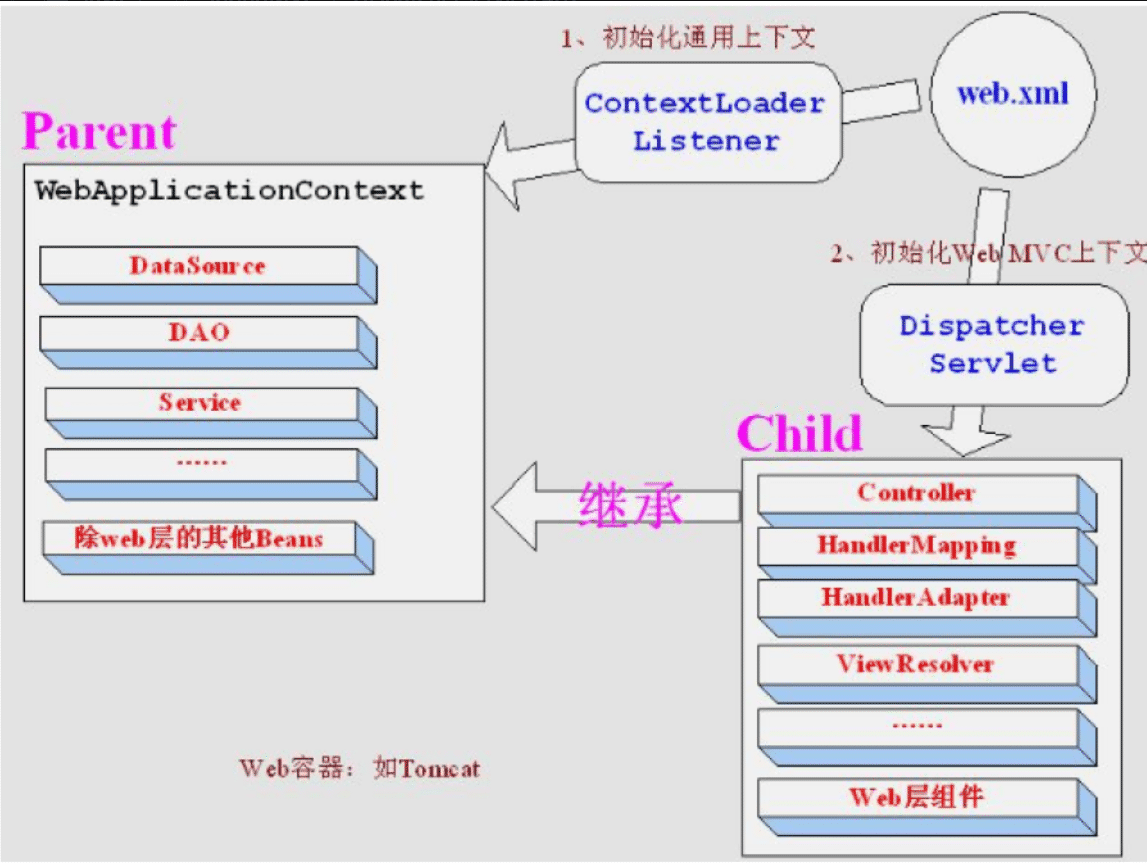DispatcherServlet 是前端控制器設(shè)計(jì)模式的實(shí)現(xiàn),提供 Spring Web MVC 的集中訪問點(diǎn),而且負(fù)責(zé)職責(zé)的分派,而且與 Spring IoC 容器無縫集成,從而可以獲得 Spring 的所有好處。DispatcherServlet 主要用作職責(zé)調(diào)度工作,本身主要用于控制流程,主要職責(zé)如下:
- 文件上傳解析,如果請求類型是 multipart 將通過 MultipartResolver 進(jìn)行文件上傳解析;
- 通過 HandlerMapping,將請求映射到處理器(返回一個(gè) HandlerExecutionChain,它包括一個(gè)處理器、多個(gè) HandlerInterceptor 攔截器);
- 通過 HandlerAdapter 支持多種類型的處理器(HandlerExecutionChain 中的處理器);
- 通過 ViewResolver 解析邏輯視圖名到具體視圖實(shí)現(xiàn);
- 本地化解析;
- 渲染具體的視圖等;
- 如果執(zhí)行過程中遇到異常將交給 HandlerExceptionResolver 來解析
DispathcherServlet配置詳解
|
1
2
3
4
5
6
7
8
9
10
11
12
13
14
|
<servlet> <servlet-name>SpringMVC</servlet-name> <servlet-class>org.springframework.web.servlet.DispatcherServlet</servlet-class> <init-param> <param-name>contextConfigLocation</param-name> <param-value>classpath:spring-mvc.xml</param-value> </init-param> <load-on-startup>1</load-on-startup></servlet><!-- servlet-mapping --><servlet-mapping> <servlet-name>SpringMVC</servlet-name> <url-pattern>/</url-pattern></servlet-mapping> |
- load-on-startup:表示啟動(dòng)容器時(shí)初始化該 Servlet;
- url-pattern:表示哪些請求交給 Spring Web MVC 處理, "/" 是用來定義默認(rèn) servlet 映射的。也可以如 *.html 表示攔截所有以 html 為擴(kuò)展名的請求
- contextConfigLocation:表示 SpringMVC 配置文件的路徑

Spring配置
先添加一個(gè)service包,提供一個(gè)HelloService類,如下:
|
1
2
3
4
5
6
|
@Servicepublic class HelloService { public String hello(String name) { return "hello " + name; } } |
添加applicationContext.xml
|
1
2
3
4
5
6
7
8
9
10
11
12
13
|
<?xml version="1.0" encoding="UTF-8"?><beans xmlns="http://www.springframework.org/schema/beans" xmlns:xsi="http://www.w3.org/2001/XMLSchema-instance" xmlns:context="http://www.springframework.org/schema/context" xsi:schemaLocation="http://www.springframework.org/schema/beans http://www.springframework.org/schema/beans/spring-beans.xsd http://www.springframework.org/schema/context https://www.springframework.org/schema/context/spring-context.xsd"> <context:component-scan base-package="org.javaboy" use-default-filters="true"> <context:exclude-filter type="annotation" expression="org.springframework.stereotype.Controller"/> </context:component-scan></beans> |
這個(gè)配置文件默認(rèn)情況下,并不會(huì)被自定加載,所有,需要我們在web.xml對其進(jìn)行配置
|
1
2
3
4
5
6
|
<context-param> <param-name>contextConfigLocation</param-name> <param-value>classpath:applicationContext.xml</param-value> </context-param> <listener> <listener-class>org.springframework.web.context.ContextLoaderListener</listener-class> </listener> |
首先通過 context-param 指定 Spring 配置文件的位置,這個(gè)配置文件也有一些默認(rèn)規(guī)則,它的配置文件名默認(rèn)就叫 applicationContext.xml ,并且,如果你將這個(gè)配置文件放在 WEB-INF 目錄下,那么這里就可以不用指定配置文件位置了,只需要指定監(jiān)聽器就可以了。這段配置是 Spring 集成 Web 環(huán)境的通用配置;一般用于加載除 Web 層的 Bean(如DAO、Service 等),以便于與其他任何Web框架集成。
contextConfigLocation: 表示用于加載Bean的配置文件
contextClass: 表示用于加載 Bean的 ApplicationContext 實(shí)現(xiàn)類,默認(rèn) WebApplicationContext。
在MyController中注入HelloService:
|
1
2
3
4
5
6
7
8
9
10
11
12
13
14
15
16
17
18
19
|
@org.springframework.stereotype.Controller("/hello") public class MyController implements Controller { @Autowired HelloService helloService; /** * 這就是一個(gè)請求處理接口 * * @param req 這就是前端發(fā)送來的請求 * * @param resp 這就是服務(wù)端給前端的響應(yīng) * * @return 返回值是一個(gè) ModelAndView,Model 相當(dāng)于是我們的數(shù)據(jù)模型, * View 是我們的視圖 * @throws Exception */ public ModelAndView handleRequest(HttpServletRequest req, HttpServletResponse resp) throws Exception { System.out.println(helloService.hello("javaboy")); ModelAndView mv = new ModelAndView("hello"); mv.addObject("name", "javaboy"); return mv; } } |
為了在 SpringMVC 容器中能夠掃描到 MyController ,這里給 MyController 添加了 @Controller 注解,同時(shí),由于我們目前采用的 HandlerMapping 是 BeanNameUrlHandlerMapping(意味著請求地址就是處理器 Bean 的名字),所以,還需要手動(dòng)指定 MyController 的名字。
最后,修改 SpringMVC 的配置文件,將 Bean 配置為掃描形式:
|
1
2
3
|
<context:component-scan base-package="org.javaboy.helloworld" use-default-filters="false"> <context:include-filter type="annotation" expression="org.springframework.stereotype.Controller"/></context:component-scan> |
|
1
2
3
4
5
6
7
8
9
10
11
|
<!--這個(gè)是處理器映射器,這種方式,請求地址其實(shí)就是一個(gè) Bean 的名字,然后根據(jù)這個(gè) bean 的名字查找對應(yīng)的處理器--><bean class="org.springframework.web.servlet.handler.BeanNameUrlHandlerMapping" id="handlerMapping"> <property name="beanName" value="/hello"/></bean><bean class="org.springframework.web.servlet.mvc.SimpleControllerHandlerAdapter" id="handlerAdapter"/><!--視圖解析器--><bean class="org.springframework.web.servlet.view.InternalResourceViewResolver" id="viewResolver"> <property name="prefix" value="/jsp/"/> <property name="suffix" value=".jsp"/></bean> |
配置完成后,再次啟動(dòng)項(xiàng)目,Spring 容器也將會(huì)被創(chuàng)建。訪問 /hello 接口,HelloService 中的 hello 方法就會(huì)自動(dòng)被調(diào)用。
兩個(gè)容器

當(dāng) Spring 和 SpringMVC 同時(shí)出現(xiàn),我們的項(xiàng)目中將存在兩個(gè)容器,一個(gè)是 Spring 容器,另一個(gè)是 SpringMVC 容器,Spring 容器通過 ContextLoaderListener 來加載,SpringMVC 容器則通過 DispatcherServlet 來加載,這兩個(gè)容器不一樣:
從圖中可以看出:
- ContextLoaderListener 初始化的上下文加載的 Bean 是對于整個(gè)應(yīng)用程序共享的,不管是使用什么表現(xiàn)層技術(shù),一般如 DAO 層、Service 層 Bean;
- DispatcherServlet 初始化的上下文加載的 Bean 是只對 Spring Web MVC 有效的 Bean,如 Controller、HandlerMapping、HandlerAdapter 等等,該初始化上下文應(yīng)該只加載 Web相關(guān)組件。
這個(gè)是不可能的。因?yàn)檎埱筮_(dá)到服務(wù)端后,找DispatcherServlet 去處理,只會(huì)去 SpringMVC 容器中找,這就意味著Controller 必須在 SpringMVC 容器中掃描。
2.為什么不在 SpringMVC 容器中掃描所有 Bean?
這個(gè)是可以的,可以在SpringMVC 容器中掃描所有 Bean。不寫在一起,有兩個(gè)方面的原因:
- 為了方便配置文件的管理
- 在 Spring+SpringMVC+Hibernate 組合中,實(shí)際上也不支持這種寫法
以上就是本文的全部內(nèi)容,希望對大家的學(xué)習(xí)有所幫助,也希望大家多多支持服務(wù)器之家。
原文鏈接:https://www.cnblogs.com/qiuwenli/p/13423900.html















